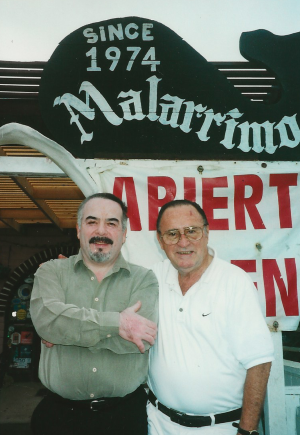 |  |
By Greg Niemann

There was no warrior there, even though the translation of Guerrero Negro means “Black Warrior.” The name “Guerrero Negro,” the largest town located in the Mulegé municipality of Baja California Sur was actually taken from English words and translated literally.
The namesake “Black Warrior” was a 231-ton whaling ship built in Duxbury, Massachusetts in 1825. For over 20 years the ship plied the Indian Ocean waters before entering the Pacific in 1847. There she covered routes from Honolulu to the Arctic to Baja California.
On December 20, 1858, captained by Robert Brown, the “Black Warrior” ran aground and collapsed at the entrance to what would later be named the “Guerrero Negro” Lagoon. The shipwreck thus spawned the name of a Baja lagoon and later nearby town. The “Black Warrior” wreckage remained at the lagoon’s entrance for decades serving as a signal to mariners of the dangerous shoals and shallow waters.
Brown was one of the whaling captains who followed Captain Charles Melville Scammon into the Baja lagoons where Scammon had earlier discovered them as the breeding grounds of the California gray whale (Eschrichtius robustus).
Prior to the discovery there were an estimated 18,000 to 22,000 whales migrating to the shallow lagoons each year from colder Alaskan waters.
Whaling continued there until protective laws for them were established in 1937, but it would be almost 100 years from the shipwreck before the town of Guerrero Negro was established between the Guerrero Negro Lagoon and the larger Scammon’s Lagoon to the south.
Aside from wintertime whaling ships, the area around the lagoons was barren and desolate. Even in the early 1900s it was just occasionally visited by fishermen. According to local businessman/historian Enrique Achoy, the first permanent settlers there were Miguel Aguilar Murillo and his wife, Fidelia Leyva Tapia, who arrived from Sinaloa state in 1926. The couple established their home on the beach and got supplies from visiting fishermen.
Shaking salt in Baja
It wasn’t the whales or fishing, however, that gave birth to the town of Guerrero Negro. It was salt – common table salt (sodium chloride) and there is so much salt in the vast tidal flats of Scammon's Lagoon (Locally called Laguna Ojo de Liebre or “Eye of the Jackrabbit Lagoon”) that the area eventually became the world’s number one salt producer, and still is today (2021).

The vision for the salt project was American shipping magnate and billionaire Daniel K. Ludwig (1897-1992). In 1954, on a trip to Baja California Sur, he recognized the incredible potential for harvesting salt. A man of action, Ludwig established Exportadora de Sal, SA, at the lagoon. As the rural area was largely uninhabited, in 1957 Ludwig arranged for the necessary workers and materials to be transported to the Guerrero Negro area. These company beginnings grew into the new town.
Exportadora de Sal S.A. diked the shallow tidal flats creating evaporating ponds approximately one meter deep and 100 meters square. After sea water rushes in and is evaporated by the sun, the salty brine solution is moved to another pan for further drying out. After the brine has completely evaporated, the salt precipitate is collected, loaded into huge triple trailer bottom dumping trucks, and driven to loading docks for shipment.
The man-made salt pans on the shores of Scammon's Lagoon cover some 300 square miles and from the air look like a huge brightly colored quilt.
Ships export the annual seven million tons of salt to the United States and Canada, as well as to countries across the Pacific basin: Japan, Korea, Taiwan and New Zealand.
In 1973, with rumors that the Mexican Government would nationalize the company, Ludwig sold his interest in Exportadora de Sal, SA to Japan’s Mitsubishi which even today owns 49%. The Mexican government holds the controlling 51% interest.
More than a company town
Guerrero Negro, the company town that grew up around the salt enterprise is located midway down the Baja peninsula just south of the 28th parallel at the northern border of the state of Baja California Sur. It had a population of 14,316 in the 2015 census, almost all (including 1,000 employees) directly influenced by Exportadora de Sal.
The town can also be reached via the Guerrero Negro Airport. Back in 1975, I had occasion to land there in a small plane making a brief stop. The airport then consisted of a lone taxi just off the runway, with its driver leaning against a small shed should anyone want to deplane and need a ride.
Exportadora de Sal, SA supports the ecological surroundings of Guerrero Negro and is located within a biosphere reserve where each winter the whales that were once hunted gather, and many species of resident and migratory birds congregate.
A whale of a time
From late December to early January, the migrating gray whales from Alaska begin to arrive in the calving areas at the lagoons (Scammons Lagoon and San Ignacio Lagoon farther south). These first whales are usually pregnant mothers that look for the protection of the lagoons to give birth to their calves, along with single females seeking mates.

By mid-February to mid-March the bulk of the population show up in the lagoons, filling them with nursing, calving and mating gray whales. The whale population in recent years often reaches 1,000 cetaceans and some even linger in the balmy Baja waters until May.
Winter becomes a whirlwind of tourist activity in the lagoon area as visitors come to experience and even pet these “friendly” whales. With the whale watching industry the main attraction, the salt company town of Guerrero Negro has become a destination.
Those who drive into central Baja will notice several guides and whale watching tours in Guerrero Negro and San Ignacio (about 50 miles south). It is easy to arrange a trip through the hotels in either town.
One example would be the Whale Watching Tour provided by Malarrimo Eco-Tours out of the Malarrimo Restaurant/Hotel in Guerrero Negro. Offering tours since 1990, during January, February and March they provide bilingual guides, round trip transportation to Scammon’s Lagoon, a three-hour boat trip, and box lunch with beverage.
I’ve often stayed at the Malarrimo Hotel and many years ago (2000) even wrote about its memorable restaurant which still serves good food. This is what I wrote:
“The Malarrimo Restaurant in Guerrero Negro is considered by many as ‘best place to dine’ between Ensenada and La Paz. It’s on the north side of the main street as you enter town and also offers good value motel rooms and a gift shop along with its signature restaurant. It seems a bit incongruous finding an upscale dining room after driving past so many small cafes and ranchos, so Malarrimo is a welcome stop. I’ve found great seafood, fresh fish, shrimp, clams, calamar and a very good seafood combination. Americans also like their breakfasts at Malarrimo which can include lobster omelets, machaca and chorizo y huevos. During the 1960s, Malarrimo owner Enrique Achoy, who was earlier a chef and translator for the salt works, had also established the old El Pollo restaurant in downtown Guerrero Negro. Now other members of the Achoy family help him run the successful and delightful Malarrimo Restaurant and accompanying businesses. Elena Achoy, for example, keeps a well-stocked gift shop next door.”

Other Guerrero Negro hotels include the Halfway Inn, Don Gus, and Hotel Caracoles. There are also a couple of B&Bs, a lodge (Hotel Ballenas), and a specialty hotel Hotel Cavare). Other restaurant options include the Santo Remedio, Tacos El Muelle, and Marios Restaurant.
To provide other activities for visitors to Guerrero Negro, the salt works now offers tours. Many whale watchers also take the time to visit the Bird Refuge (Refugio de Aves). The refuge, which features a diverse range of almost 100 species of birds, can be reached by a short walk from town (Near the Banamex). There’re also some large and breathtaking sand dunes (Dunas de Soledad) just outside town.
Guerrero Negro has a celebration each year to hail the annual arrival of the whales. This Whale Festival normally occurs during the first half of February.
Into the lagoonsA virtual oasis, the pretty mission town of San Ignacio is the closest to the San Ignacio Lagoon. San Ignacio has a few hotels and a couple of RV parks and campgrounds. From San Ignacio, you can also drive 42 miles of dirt road (1½ hours) to that lagoon and meet with a local guide.
Whale watchers can also find numerous package tours from southern California, especially San Diego, and also from Ensenada. One tour arranged through the San Nicolas Hotel in Ensenada offers transportation, two nights in a motel, lunch, snacks, sodas, and a guided panga trip into the lagoons.
Other tours include Baja Expeditions, and Baja Discovery Tours. There are many choices, from quick trips of a few days to a week or more, from roughing it to more comfortable accommodations.
It’s an awesome experience to encounter and actually touch the incredible friendly gray whales in the Baja lagoons.
If you visit Guerrero Negro, you can also dazzle your friends with some trivia: that the town is named for a shipwreck, and got its start processing vast acres of salt. With over seven million tons harvested per year – it still fills a lot of salt shakers!
About Greg
Greg Niemann, a long-time Baja writer, is the author of Baja Fever, Baja Legends, Palm Springs Legends, Las Vegas Legends, and Big Brown: The Untold Story of UPS. Visit www.gregniemann.com.

Buying insurance on line is the most efficient way to go.

Easy transaction. They already have all my information on file so I get my policy in less than 5...

Easy process to obtain insurance for my trip. The company reminded me a week before the trip to...